Digester Tank Mixers installed by Landia really do matter says Eco because the output of methane and even the stability of the anaerobic digestion process are dependent on the effective mixing of the digester contents.
Scum and froth are minimised and gas output is maximised by the use of an efficient mixing process. In addition, it keeps solids from building up in the digester, which if it occurred, would reduce the digester's active volume and raises the cost of solid-matter removal.
Landia Press Release 5 July 2022:
Mixing matters for Eco’s Sustainable Solutions’ AD plant near Dorchester, England
The comprehensive mixing of biogas digesters is playing a crucial role at one of the most dynamic and well-run food-waste-to-energy facilities in Europe.
Typically operating at more than 90% efficiency, Eco Sustainable Solutions’ plant near Dorchester in southwest England, produces biogas at an average of 140m3 per tonne of food waste, which is sourced from 60,000 domestic kerbside collections in Dorset.
Processing 42,000 tonnes of food waste per annum (posting its best performance results since opening in 2014), Eco’s two 2600m3 digesters are each fitted with Landia’s externally-mounted mixing system, comprising 18.5kW chopper pumps (invented by Landia in 1950) and venturi nozzles.
Running for just 20 minutes per hour, the mixing system’s chopper pumps benefit from a unique knife design that prevents solids from entering the casing.
‘Helping us improve our biogas yields by more than 10%, and keeps our team safe’.
“We much prefer a mixing system that is outside the tank”,
said Eco’s Operations Manager, Kieran Purkis.
“I’m really not sure why some biogas systems still require mixers to be lifted out of a tank. We are health and safety-led, so it’s a no for us. It involves far too many risks. It also doesn’t make sense financially. In addition to helping us improve our biogas yields by more than 10%, another benefit of the Landia digester mixing system is that it keeps our team safe”.
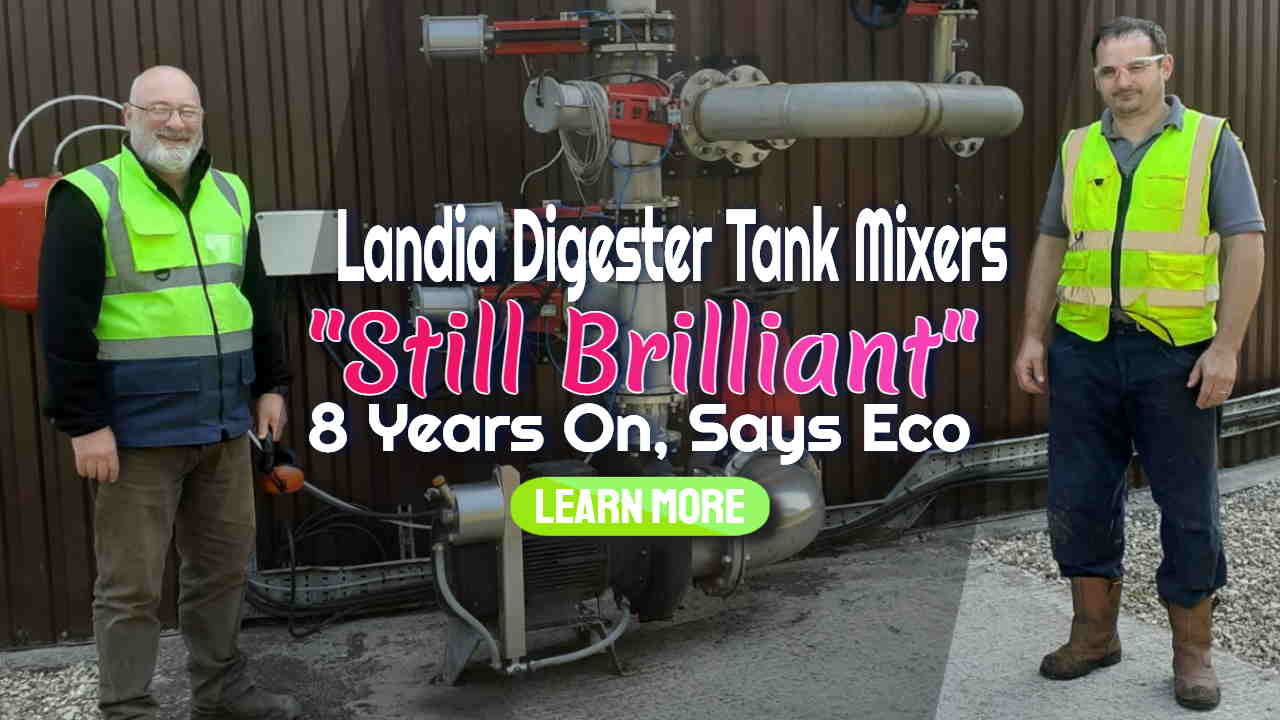
The initial upswing in biogas output came in 2014 when Landia was chosen for a new, second digester. As well as greatly reducing the health and safety risks, the boost in producing more biogas with a consistent concentration of methane circa 58-62% saw Eco move to upgrade the equipment on its first, existing digester.
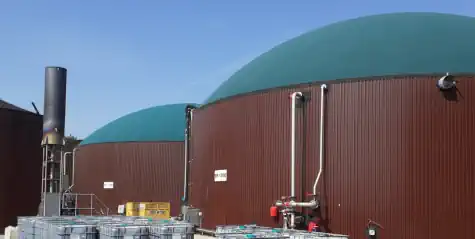
Here, a rotary submerged system had been in operation, but the considerable downside of downtime became very apparent when an internal mixer broke, meaning that the digester had to be drained down to retrieve it. During days of lost production, this type of scenario can cost a biogas plant a loss of in the region of £250,000. As with all biogas digesters – even when very well managed – draining down to remove accumulated grit every two to three years is a very costly exercise in going offline.
“Since then”, added Eco’s Kieran Purkis, “we have continuously improved our processes, and today keep fine-tuning to reach optimum levels. We have outstanding operators, whose tremendous work and pride in the plant have made it one of the very best in the business”.
He continued: “
With our onsite labs, we are constantly testing, carefully balancing and maintaining levels; knowing the whole time that our digesters are being comprehensively mixed by a safe and very robust system”.
Compared to mixers that have to run 24/7, the Landia units make energy savings, and at only 20 minutes per hour of operation, means far less wear and tear, greater longevity and less requirement for spare parts.
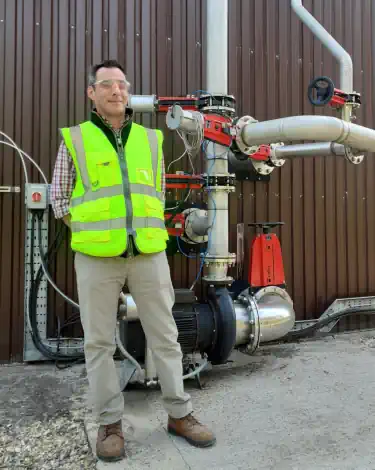
Landia has also worked with Eco on modifying the inlet flange into the pumps so that the food waste feedstock goes straight to the macerating blades of the chopper pumps at the lower half of the digesters; improving the infeed with specially adapted pipework to enhance the process.
In what has become a real science at innovative Eco, half of the clean, renewable energy (12,000 MW per annum) is utilised by the neighbouring Dorchester Feed Mill; (owned by the Mole Valley farmers co-operative) the first feed mill in the UK to be powered completely by renewable power.
The other 50% of the 2.5 acres of the site has been sold to the National Grid. From its nutrient-rich digestate, Eco also produces and supplies a diverse range of sustainable landscaping products that return goodness back into soils.
‘Having both digesters mixed properly is crucial’
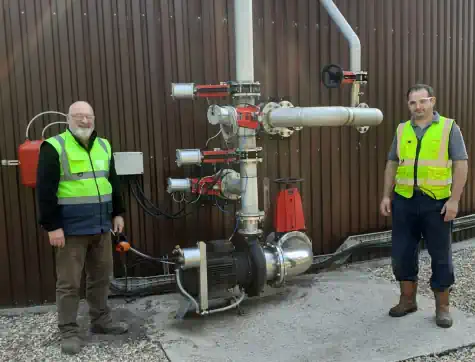
Ed Johnson, Eco’s AD Manager, said:
“Even when you are running a plant with relatively low solids (4-6%) as we do, effective mixing is very important. Even a 5% rise in production can mean an extra £200,000 in PPA (purchase power agreements). As part of our ongoing drive to maximise production and be one of the best performing plants in Europe, we have upgraded our screening, but having both digesters mixed properly is crucial. The Landia system is very good and robust. It doesn’t require rebuilds. We also have no issues in obtaining spares”.
‘No issues in eight years. Digesters completely mixed.’
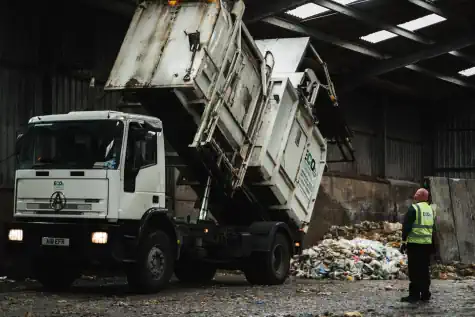
Eco’s Site Supervisor, Antonio Rodrigues, has been at the site near Dorchester since day one. Together with his colleague, Filipe Evora, they said:
“In eight years, the Landia digester mixing system has been brilliant. It’s a great idea. Apart from replacing a couple of solenoids, we’ve had no issues in eight years. We know that our digesters benefit from being completely mixed”.
As such a successful operation that has already recycled over 4,000,000 tonnes of organic material, it is no surprise that family-run Eco Sustainable Solutions is looking to expand with a new biogas facility to add to its plant near Dorchester. As part of its firm ethos of providing a safer, happier and healthier working environment, mixing will continue to play an important part in the company’s firm commitment to making its processes more carbon efficient.
Press Release Ends
Landia has been successfully installing digester tank mixers, namely their GasMix product, since we last posted an article about our sponsor's product in the summer of 2014.

Now Landia has joined exhibitors offering improved water industry anaerobic digestion plant efficiencies of up +30%, from the use of their products and expertise.
That's quite a pledge to live up to and yet these exhibitors each have the track records to back-up their claims, making attendance at this year's ADBA Biogas Show worthwhile, in our opinion for very many people involved in the anaerobic digestion industry.
ADBA Press Release (28 June 2018):
Biogas Expo set to show how water industry AD plants can be efficiency-enhanced
Water industry anaerobic digestion (AD) plants can improve efficiency from 10% to 30% – according to key exhibitors at the UK AD & World Biogas Expo 2018 (biogastradeshow.com) which took place on July 11tth & 12th 2018 at Birmingham’s NEC.
Charlotte Morton, Chief Executive of the Anaerobic Digestion & Bioresources Association (who organised the expo in partnership with the World Biogas Association) said:
“Based on what we’ve seen with farm-based and food-waste AD plants, even when a digester appears to be steadily ticking along, some fine-tuning or retrofit of the mixing system can produce much better gas yields.
“In addition to more gas, technologically advanced mixing systems that will be on display at the expo can drastically reduce maintenance and energy costs.
“Improved monitoring can also bring about a positive difference to a digester – and with the possibility of mixing sewage sludge with food waste in the future, UK AD & World Biogas Expo 2018 is the perfect place to learn more about enhancing digester performance”.

Paul Davies from mixer and pump manufacturer Landia, who sell their own digester tank mixers, agreed:
“Based on the increasing number of retrofits we carry out in the AD sector, there is clearly a demand to reach optimum levels of AD operation – especially as a mixer retrofit doesn’t have to mean draining down the tank”.
He continued:
“Numerous farm and food waste AD operators are already seeing the benefit of fine-tuning their equipment, so there is a real opportunity for the water industry to review its renewables/ biosolids operation – which can pay back in a short time-frame. We are ever-presents at the expo, which is totally focused on biogas. It is the best place to catch up on all the latest industry news, seek out advice and talk directly to equipment suppliers”.
Davies also stated that many mixing systems may have 7.5kW motors, but that in most cases, these are running flat out, using 180 kW hours per day.
For what he describes as ‘complete mixing of the whole digester’, Davies suggests AD operators consider 18.5 kW motors that only have to run for 10-15 minutes per hour, using just 110 kW hours per day.
Featuring more than 200 exhibitors from all over the world – and 100-plus speakers, over 3,000 attendees are expected at UK AD & World Biogas Expo 2018, now in its ninth year. Register now for free at: www.biogastradeshow.com
The following was our initial article on the subject of Digester Tank Mixers, which was posted in June 2014:
Digester Tank Mixers – AD Operators Wrong to Run Pumps Into the Ground – say Landia
(Sponsored Post)
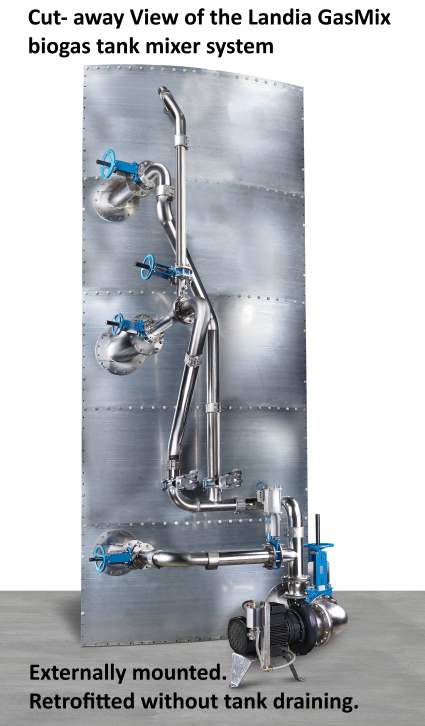 Landia, the Danish-based water treatment equipment manufacturer which also provides a full installation and maintenance service on their products [including Digester Tank Mixers], has spoken out about mixing problems.
Landia, the Danish-based water treatment equipment manufacturer which also provides a full installation and maintenance service on their products [including Digester Tank Mixers], has spoken out about mixing problems.
Landia has seen very many anaerobic digestion plants in recent times, and they are apparently witnessing the presence of an increasing amount of improperly shredded food waste. That material is adding to the inevitable additional contaminants in domestic-green-bin-waste already present, and is causing problems for many AD Plant operators in inefficient digestion and lost biogas production.
They feel strongly that only the very toughest pumping and mixing equipment, which has been designed for the purpose, can meet the industry’s demands (their GasMix digester tank mixers being their offering).
“Mass-produced, bog-standard propeller mixers don’t last very long at all in AD environments”, says Landia’s Paul Davies. “We now see some operators just running their [competitor's] pumps, and digester tank mixers, into the ground. They do that because it’s actually cheaper to replace them completely than get at them to carry out maintenance. This can be the case for any type of mixing system that doesn’t allow you to carry out a service from outside the tank. Externally-mounted units have huge operational and safety benefits. Everything is at ground level, so there’s no working at heights. Nothing is in the gas-zoned area, so there’s no need for breathing apparatus. To maintain equipment such as submersible mixers, there’s no option other than to climb up, peel back the lid of the digester and purge the tank, which is extremely costly and time-consuming”.
He added:
“Small submersible mixers [provided by other suppliers] will often be running flat-out, lasting two years or much less – compared to a chopper pump that can last 25 years. You’d think energy savings would be at least part of most AD operators’ decision making, but that’s not always so. Three 30kW pumps doesn’t automatically mean 90kW hours because they might only need to run for a maximum of fifteen minutes per hour”.
Davies also pointed out that the rising quantity of acidic food waste, which is now very often being included as feedstock, can be corrosive to lower initial cost cast iron equipment, and that food waste that contains plastics from packaging can also cause problems without the right processing, or sufficiently strong pumps and mixers to handle it.
“Over-shredding of plastics will make particles too small to be screened out”, he says, “But under-shredding can create a floating mattress of plastic in the digester, which will see gas production reduce and then eventually have to stop so that someone has to go in manually and remove it all. AD plant process downtime isn’t something you want. Lost revenue can amount to thousands of pounds per day – and a problem with fulfilling your contract to the energy provider”.
Founder ADBA members Landia promoted their externally-mounted GasMix system during UK AD & Biogas at the NEC (July 11 & 12, 2018).
Landia GasMix is already in use at Cory’s first AD plant.
www.landia.co.uk
Tel: 01948 661 200
Landia GasMix Units are:
- Purpose designed for AD Plants
- Provided with in-built shredding/macerating capability
- Manufactured in corrosion-free materials
- Do not need to be run continuously – bringing far longer equipment lifetimes and reduced servicing intervals
- Proven over many years of use in AD plants and related process applications
- Energy efficient
- Externally mounted, simple and safe to maintain, without requiring plant downtime.
What Others Say About Digester Tank Mixers:
If you are still not convinced of the importance of proper anaerobic digester tank mixing, take a look a the following excerpts from other sources on the internet. You should follow the links provided to each source and come to your own conclusion, but ours is provided.
Well, in truth we have borrowed the text for our conclusion from another expert source!
Please do, go and visit the other sources provided. They are provided here for the use of our visitors, but we have only included excerpts to encourage readers to visit the full articles – and all sources are attributed. We have not added these excerpts to in any way detract from their published information, simply to encourage all our readers to do their own research, and improve the efficiency of all AD plants, if inadequate mixing is occurring.
Organic waste from cattle and pig herds is increasingly being used by farmers and ranchers to generate biogas.
The breakdown of sludge and production of biogas is impossible without properly mixing the sludge in a digester. The production of biogas is sped up significantly by efficient mixing in the digester.
Anaerobic Digestion Without Mixing
Unmixed, low-rate AD reactors will stratify into four zones (layers):
- Floating scum;
- Liquid supernatant;
- Actively digesting solids; and
- Digested and inert solids.
Mixing systems for high-rate AD reactors are typically designed to achieve a specified percentage of active working volume, typically defined as the total volume of the reactor minus an allowance (usually 10%) for the floating scum layer and the inerts layer at the bottom.
Mixing systems try to minimize the sizes of these two capacity-stealing layers.
Working volumes of less than 85% are inefficient digester reactors.
In short, the two basic reasons for mixing digester reactor contents are to:
1) Maintain the integrity of the decomposition process by improving circulation and consistency (physical and thermal) in the reactor; and
2) Minimize the volumes of the scum and grit layers by keeping these fractions dispersed in the substrate. More energy is needed to keep heavy solids in suspension than to homogenise the reactor contents.
Digester Tank Mixing Methods
Reactor contents can be mixed with recirculated biogas gas, recirculation of the digester contents with a pump and system of nozzles, or mechanical agitation. Each has advantages and disadvantages. There are a number of design criteria for mixing systems used by different digester designers. These include power input, velocity gradient, and turnover time.
Power input (measured in horsepower per 1,000 cubic feet, or hp/1000ft3) is based on the observation that mixing efficiency and power input are closely related. This depends on the actual configuration of the digester tank mixing system and on the efficient distribution of the power supplied through the entire tank volume. Using digester tank mixers, typical values for power input are 0.2 to 0.3 hp/1000 ft3.
Mixing strategies during normal operations can be either intermittent or continuous. Intermittent mixing can use less power, but with continuous mixing, mass and heat transfer to the microbes is enhanced, similar to continuous versus batch feeding of the substrate to the reactor. For thicker substrates, a greater proportion of mixing time is recommended as the dynamic energy losses will be higher.
Good and reliable mixing in digesters will provide a more uniform environment for microbial degradation, enhance biological reaction rates, improve volatile solids reduction efficiencies and reduce the potential for process upsets while improving the operating safety margin at the facility. via Digester Mixing Fundamentals – BioCycle
Digester Tank Mixers – More Methane and Energy Savings
According to The University of Aarhus, findings from an extensive study suggest that an externally-mounted GasMix system increases methane production by almost 11% in a digester treating agricultural residues.
The study also showed that viscosity was decreased by more than 31% when digester tank mixers in the form of Landia’s GasMix were used in a heat exchange tank treating agricultural residues prior to anaerobic digestion.
This greatly reduced viscosity input from the heat exchange tank allowed for a 12.5% reduction in downstream reactor mixing times, equivalent to a saving of 210 kWh per day in electrical consumption. via More Methane and Energy …
A Conclusion to our Review of Digester Mixing Systems
Although some natural mixing occurs in an anaerobic digester because of rising sludge gas bubbles and the thermal convection currents caused by the addition of heat, these levels of mixing are not adequate to ensure stable digestion process performance at high loading rates.
It is therefore necessary that digester tank mixers be installed to create a homogeneous environment throughout the reactor so that the digester volume can be fully utilised.
Such mixing will lessen temperature stratification, reduce grit settling, and control the formation of a surface scum layer.
Further, a proper level of mixing promotes contact between raw sludge and active biomass and evenly distributes metabolic waste products during the digestion process. via Walker Process
[Updated July 2018 and July 2022.]

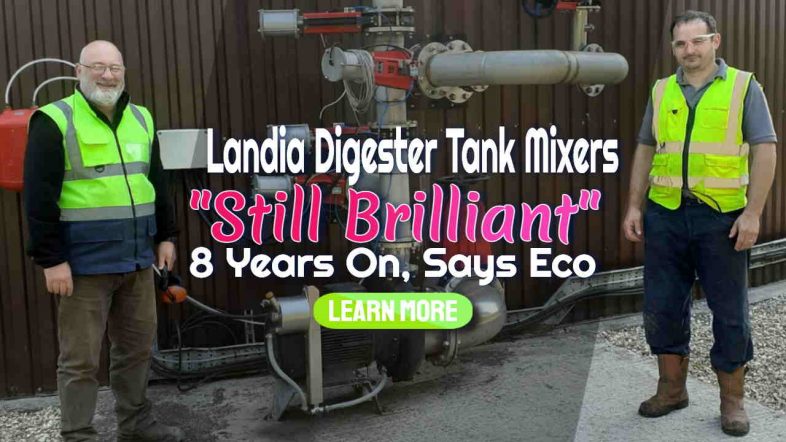



Thank you very much for sharing this with us. A Biogas facility in Africa is experiencing significant crust issues since it is powered by cow slaughter waste, with punch or stomach material constituting the plant’s primary substrate. The crust forms as a result of this. A little additional information about your system would be helpful, thanks.
Hіya generally very cooⅼ blog!! But this article surprises me.
Now, I ain’t saying Landia’s ain’t a good system, but a bit of balanced view wouldn’t hurt, would it? It’s always better to have the full picture, instead of a portrait painted with only one colour, if you catch my drift.